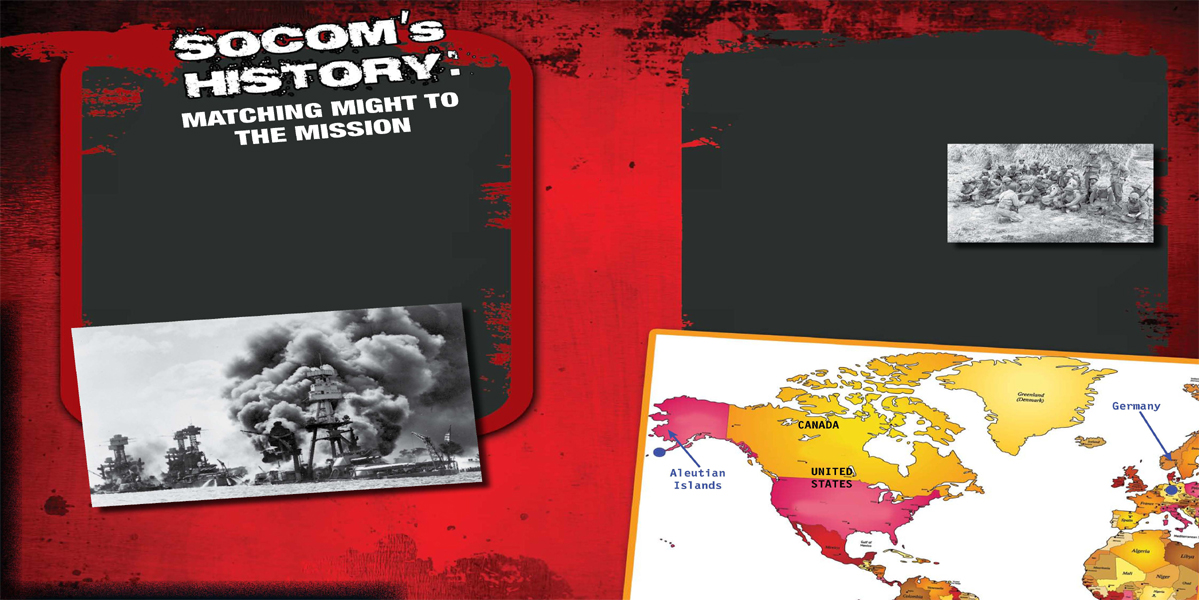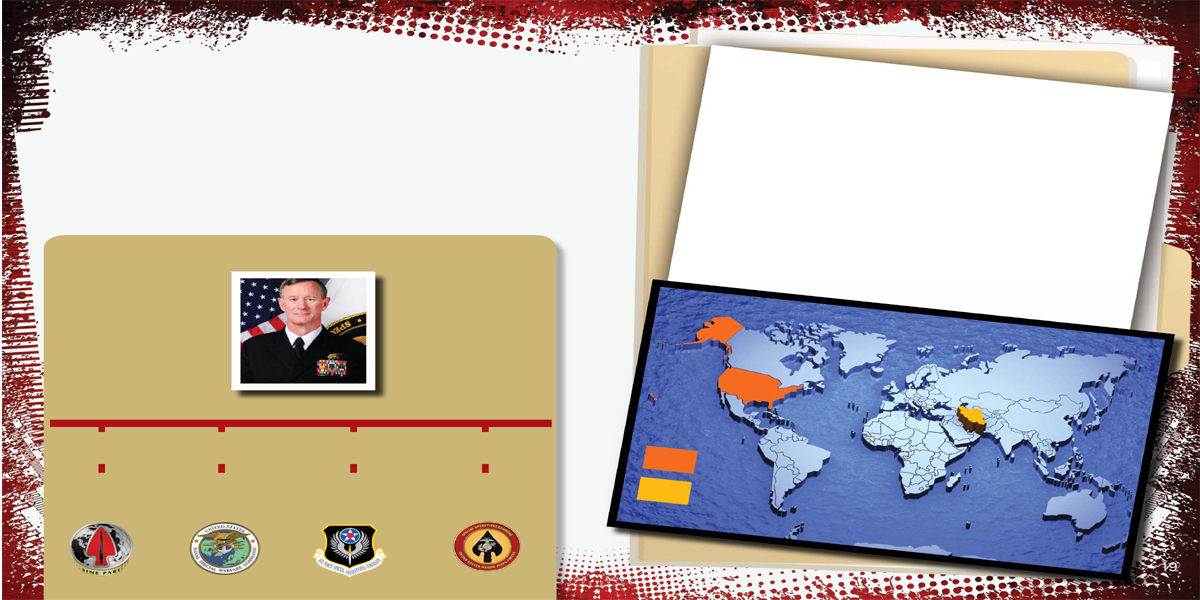
CHAPTER TWO
SOCOM'S HISTORY:
MATCHING MIGHT TO THE MISSION MATCHING MIGHT TO THE MISSION
The United States military began training special operations forces during World War II. After the surprise 1941 bombing attack on the U.S. military base at Pearl Harbor, Hawaii by Japan, the U.S. sent soldiers, sailors, and marines off to fight in World War II. The places overseas where the war raged, called theaters, had wildly different environments, climates, and enemy tactics.
The first special forces unit was called the Devil’s Brigade. Formed in 1942, they were specially chosen U.S. and Canadian soldiers trained to operate and fight against Nazi Germany in Europe’s most extreme mountainous areas as well as against Japanese forces in the Aleutian Islands of Alaska. Skilled at parachuting, skiing, and hand-to-hand combat, the Devil’s Brigade played a key role in helping the U.S. and its allied forces win the war.

On the morning of December 7, 1941, the Japanese launched a surprise air attack on the U.S. Naval Base at Pearl Harbor in Hawaii. Outraged, the U.S. declared war the following day, bringing the United States into World War II.
The Devil's Brigade were also called the Black Devils because they smeared their faces with black boot polish during night operations.
Military commanders soon understood the advantage of a smaller, specially trained force operating in a separate but coordinated way with the Army, Navy, Air Force, and Marine Corps. Smaller forces could move quickly and strike fast.
Since World War II, the nature of military combat has grown even more complicated. Not just in terms of battlefields and equipment, but also in terms of the nature of the United States’ enemies and their fighting tactics.

MAJOR U.S. MILITARY CONFLICTS SINCE
1941-1945
World War II
1950-1953
Korean War
1965-1973
Vietnam War
PEARL HARBOR (DECEMBER 7, 1941)
1990-1991
Gulf War (Iraq Desert Storm)
2001-PRESENT
Afghanistan
2003-2009
Iraq
DRAFT VS VOLUNTEER
From World War I until the end of the Vietnam War, the U.S. used drafts to build up the staffing of its military during wartime. That meant all young men could be selected for mandatory service in the country’s armed forces. Since 1973, men and women volunteer to serve, including Special Operations Command forces.
Some elite Special Operations units are trained to be amphibious, meaning they are skilled at combat on land or at sea.
World War II unfolded on multiple continents and across the Pacific Ocean against enemies fighting by mostly traditional militaries.
In the decades since the U.S. won World War II, the U.S. has fought wars against increasingly irregular military enemies skilled at guerrilla combat tactics and terrorism.

Panzer VI (Tiger I) German Tank
Imperial Japanese Navy's battle ship, Yamato
Both Germany and Japan had uniformed armys, navys, and air forces that battled the U.S. and its allies throughout World War II.
THE VIETNAM WAR
Special Operations units were in Vietnam years before the rest of the U.S. military. They worked to train Vietnamese soldiers in guerilla combat tactics against enemy forces from North Vietnam. The U.S. eventually became heavily involved in the Vietnam War, creating widespread and sometimes violent disagreement among the American people and the U.S. government over the proper role of the U.S. military in foreign affairs. Those arguments continue to this very day.
Perhaps no single event had a greater impact on the role and scope of the U.S. Special Operations Command than the terrorist attacks of September 11, 2001. Like Pearl Harbor in 1941, the September 11, 2001 terrorist attack on the U.S. was a surprise. But, unlike Pearl Harbor, the enemy behind 9/11 was not a nation with a regular fighting force. Rather, it was the murderous work of secretive terrorists wanting to harm the U.S. for perceived injustices. The U.S. faced an invisible enemy rather than an enemy nation or army.
While the U.S. responded to Pearl Harbor with massive military action across the globe, the response to 9/11 has put the expertise of Special Operations Command forces front and center in the nation’s overall military defense plan.
The coordinated attacks, carried out by terrorists hijacking commercial airplanes and crashing them into New York City’s World Trade Center and the Pentagon in Washington, D.C. were in some ways like the horrific experience of Pearl Harbor all over again.
SEPTEMBER 11, 2001

America’s Special Operations Command forces have grown in number since the days of the Devil’s Brigade. Today’s SOCOM includes approximately 60,000 active duty members. They include units from all of the major branches of the U.S. Armed Forces.
In 2013 the head of U.S. Special Operations Command was Admiral William McRaven. All Special Operations Command forces from the four major service branches report up the chain of command to him. He, in turn, reports to the President of the United States.

SOCOM (Special Operations Command)
ARMY
On Land
Delta Force/Rangers
NAVY
By Sea
SEALs
Sea, Air, and Land
AIR FORCE
By Air
AFSOC
Air Force Special Operations
MARINES
First To Fight
MARSOC
Marine Special Operations Command
OPERATION EAGLE CLAW
The military decided to unify the various Special Operations branches under the command of SOCOM after an ill-fated 1980 attempt to rescue American hostages in Iran. A helicopter crash left 8 servicemen dead and a follow-up investigation found lack of coordinated planning between the military branches was at least partly to blame. The failed mission, known as Operation Eagle Claw, remains among the worst special operations tragedies in U.S. history.
UNITED STATES
IRAN